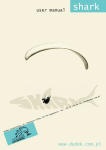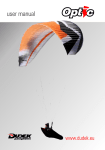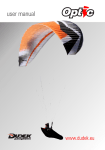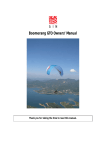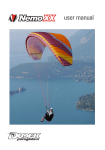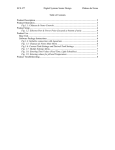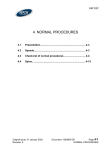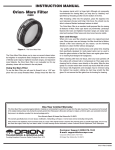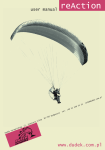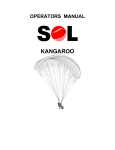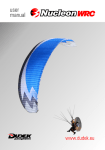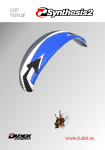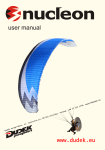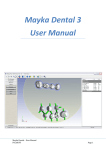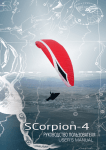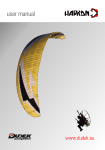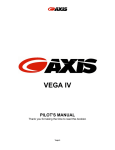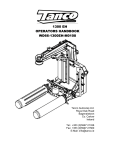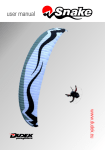Download www.dudek.eu
Transcript
ek Dud Par lna tra Cen . l u rs, ide agl , and Pol o, k s el Osi 31 6-0 8 2U, . tel 17 324 052 40, .eu dek @du t r o exp www.dudek.eu CONTENTS Page 1. Introduction...........................................................................................3 2. On the wing...........................................................................................4 WHO SHOULD FLY NEMO? THE MATERIAL RIGGING SYSTEM RISERS 3. Speed system........................................................................................6 SPEED SYSTEM ADJUSTMENT SPEED SYSTEM USAGE 4. Harness................................................................................................10 5. Flight....................................................................................................10 PRE-FLIGHT CHECK LAUNCH TURNS THERMALLING AND SOARING FLYING WITH SPEED SYSTEM ENGAGED LANDING WINCHING AND MOTOPARAGLIDING AEROBATICS 6. Rapid Descents...................................................................................14 BIG EARS SPIRAL DIVE B-STALL 7. Extreme Flying Manoeuvres..............................................................15 ONE SIDED COLLAPSE SPIN AND FULL STALL WING OVER FRONTAL COLLAPSE LINE OVER PARACHUTAL STALL EMERGENCY STEERING 8. Canopy Care........................................................................................17 STORAGE CLEANING REPAIR DETERIORATION: A FEW TIPS! 9. Technical data.................................................................................19 10. Warranty, AeroCasco........................................................................20 11. What have you bought......................................................................22 12. Rigging tables....................................................................................23 NOTE! Please read this manual before your first flight USER MANUAL 1. Introduction CONGRATULATIONS! We are pleased to welcome you among the number of discerning Dudek Paragliders pilots. You are now the proud owner of a state-of-the-art paraglider. Extensive development by using the most modern methods and thorough tests make the Dudek NEMO a user-friendly paraglider without neglecting performance and fun of flying. We wish you many enjoyable years flying your new Dudek NEMO. DISCLAIMER. Please read this Manual carefully and note the following details: $ The purpose of this Manual is to offer guidelines to the pilot using the Dudek NEMO wing and it is by no means intended to be used as a training manual for this or any other paraglider in general. $ You may only fly a paraglider when qualified to do so or when undergoing training at an accredited School or with an Instructor. $ Pilots are responsible for their own safety and their paraglider's airworthiness. $ The use of this paraglider is solely at the user's own risk! The manufacturer and distributor do not accept any liability. $ This paraglider on delivery meets all the requirements of the CEN/AFNOR. Any alterations to the paraglider will render its certification invalid. NOTICE Dudek Paragliders warns that due to constant process of development the actual paraglider may differ slightly from the one described in the manual. 3 2. On the wing WHO SHOULD FLY NEMO? You are beginning your paragliding career and have just decided to buy your first wing. It is quite an expense, so your craft should be as versatile and long-lasting as possible. You haven't yet discovered what kind of flying will be your favourite, so you would like to try everything: soaring the cliffs and diving off mountain peaks, flatland tow-launches and of course also paramotoring. You want to master thermalling skills and speed-bar usage on glides, but first and foremost you want to enjoy the mystical experience of flight without any disturbances from your wing. Of course, there is still a lot to learn, so your wing should be forgiving of occasional faults, yet have enough performance to let you experience some real adventures. Sounds like fiction, doesn't it? Well, not any more. Such a wing exists, and it is called NEMO. Nemo is a modern paraglider with good performance and a big safety margin. It is dedicated for the use of novice pilots, but is capable of motorised flight, winching and instruction as well. Nemo has a slim, elliptical planform with slightly rearward swept tips. Its double cells ensure a smooth upper surface, exact aerofoil reproduction on the entire wingspan, and - most importantly - fewer suspension points. The overall line length has been greatly reduced, thus decreasing associated parasitic drag. Low drag coefficient means that wing performance and glide ratio has become even better. Each wing tip consists of four additional cells, creating stabilisers. Their job is to make sure that the wing always flies straight, while the turns remain even and effective. Nemo's aerofoil was developed basing on experience gathered with our previous designs and tested numerically by specialised software. Thanks to its unique shape, this profile features a high safety factor with good overall performance. The precise shape of the leading edge is assured with mylar reinforcement. Laminated dacron tape is also used at the air intakes and trailing edge. And finally, mylar flares take care of equal load distribution on the suspension points. Cross ports provide good air movement inside the wing and its quick inflation. Yet the number of ports has been reduced, so that the profile of the canopy is less affected. 4 USER MANUAL Our paragliders are manufactured using the best materials available. We are sure, it's safety and reliability that counts, not price. Such an attitude allows us to extend the guarantee period up to three years - more details on Page 20. THE MATERIAL Each fabric has its own characteristics, so the materials must be properly matched in order to create a paraglider that behaves harmoniously. For the upper surface of NEMO we used a Porcher 9092 fabric, named SkyTex Aquatic (44g/m˛). Basically it's a nylon material covered with superb E85A impregate, introduced into mass production in January 2002 after a series of extensive laboratory and real flying tests. Such covered fabric is not very stiff and - what's most important - has increased tear, stretch and UV resistance. It is not silicon, so minor repairs can be easily made with self-adhesive strips. The lower surface is made of SkyTex 9017 with E38A impregnate (39g/m˛). This fabric has a great weight/resistance ratio and is one of the greatest Porcher Marine successes in providing proper materials for the paragliding industry. The ribs must be as rigid and stretch-resistant as possible. We found these qualities in SkyTex 9017 with E29A impregnate. RIGGING SYSTEM We chose latest Cousin Trestec product here, that is Dyneema Ultimate Prestretched lines. It features high wear resistance and is very strong while relatively thin. Dyneema Ultimate is additionally stabilized during production process - each thread is first stretched with carefully chosen force and then thermally stabilized in strictly observed temperature. As a result we got a line that is a lot less elastic, less likely to shrink while wet and with equal load distribution on entire length. All NEMO lines have coloured polyester sheath covering a core inside. The rigging system consists of individual lines looped and stitched at each end. There is a high diversity of lines used, as we wanted to have best strength/diameter ratio in each lines group, depending on existing loads (see table on pages 25-26). The upper level (gallery) lines start at the attachment points. Every three lines adjoin to one suspension line. Main suspension lines attach to risers with triangular quick links (maillons). The stabilizer lines connect the outer suspension points to the maillons in cascades as well. The same story goes as for steering lines. With consecutive cascades they lead down to main brake lines which then go through pulleys connected to the C-riser and finish at the brake handles. 5 Main brake lines are attached to the brake handles at their optimum trimming point, marked on the line by a black dot. This adjustment ought not be altered. Having the handles attached above optimal marks will cause permanent brake application and possible accidents. Attachment below these points is not advised too, as it will significantly diminish tension of the trailing edge, thus changing wing behaviour in some situations. Suspension lines are coloured depending on their strength and diameter as follows (colour code can be slightly different): diameter: 1,9 mm; strength: 328 daN; colour: blue diameter: 1,5 mm; strength: 216 daN; colour: red diameter: 1,1 mm; strength: 128 daN; colour: green The main suspension lines are connected to the risers with triangular metal maillons. RISERS In the Nemo we used threefold risers (with A riser split into A and A'), prepared to use with a speed-system. The outer A suspension line connects to an elongated A' riser (blue), other A lines to proper A riser (gold), B and stabilizer lines go to B riser (red), C and D lines to C riser (grey), which through pulleys keep the steering lines too. As already mentioned, risers are coloured for differentiation purposes: A - gold used for launching, A' - blue used for Big Ears, B - red used for B-stall, D - grey used for deflating the canopy in strong winds (aborting launch). Double Comfort Toggle DCT: in order to satisfy different needs of our clients we have created a Double Comfort Toggle system. With this solution it is possible to have your brake handles in stiff or soft configuration, with no need to buy another set of toggles and replace them every time. All you have to do now is take out the stiffening rod and there you are - the soft handle is ready to use. 6 USER MANUAL RISERS A A’ B C steering lines brake line pulley 120 mm brake handle 130 mm pulley magnetic clasp hooks pulley for additional brake line pulley (PPG set) 95 mm 480 mm 135 mm 50 mm 100 mm rubber "O rings" to carabiner to speed bar 7 3. Speed system The heart of the speed system is a line sewn into the A riser, running through two pulleys and finishing in a loop and a small hook. There you attach the speed bar line. In normal flight all the risers have the equal length of 50 cm. The speed system affects the A risers (together with A'), B and C. When the bar is pushed, the A and B risers gradually shorten, until there is a 2-cm difference between them. Their minimal length is respectively 37 and 39 cm. The C risers remain unaffected. An incorrectly fitted speed system leads to loss of certification! SPEED SYSTEM ADJUSTMENT Most modern harnesses are equipped with special speed system pulleys and sometimes even their own integrated speedbar. If this is not the case, first you need to have some pulleys attached in such a way that will allow the pilot to maximize the output of his/her legs with the correct power vector, without pushing the harness back. The speed system cord must be firmly attached (with a bowline or other non-slip knot) to the speed bar. The other end of the cord must be run upward through the harness pulleys, to be firmly attached to a hook or small carabiner with a strong spring action. The overall length of the speed system cord should allow the pilot to put his/her feet easily on the bar when in flight, and yet should be short enough to cover the full speed range.To exercise full speed with the NEMO speed system, a double speed bar is advised. Make sure that both cords on the speed bar are equal, as even a slight difference can result in the constant turning of the paraglider. Test your speed system thoroughly on the ground before flying with it! The maximum effect is reached when the speed system pulleys touch. SPEED SYSTEM USE Attach the paraglider risers to the harness by the principal carabiners. Then connect the speed system cords with hooks or quick-links. Before launching make sure that the speed system is untangled and runs freely. To use the speed system simply place your feet on the speed bar and push forward in a horizontal plane. If you notice a sudden loss of pressure on the bar, it can be the sign of an imminent frontal collapse. In this case release the bar and thus the speed system immediately. Watch out for such things quick wits can spare you most collapses and in general increase your awareness of what's going on around you. Slight speed-bar operation can also optimise your flight, i.e. when entering a thermal. Speed system 8 USER MANUAL RISERS - FULL SPEED A decreasing A and A’ row (130 mm) A’ B C decreasing B row (110 mm) 9 activation diminishes your paraglider angle of attack, so that its airspeed is increased. Yet simultaneously the canopy is less stable - that's why you should avoid using the speed system in turbulent conditions, close to the ground or near other airspace users! Do not use the speed system in any extreme manoeuvres! If the canopy does collapse, release the speed bar immediately and correct the situation as usual. 4. Harness Dudek NEMO pilot will fly happily using any certified harness with a hang point between 35 cm and 49 cm from the seat (however the safest distance is 40 cm). The distance between carabiners should be between 37 cm and 45 cm, though in this case the best option is 40 cm too. Please note that any modification of the seat/hang point distance changes the position of the brakes in relation to the pilot's body. You must remember that in each configuration the effect of your hand movement will be different. Caution! Too tight cross straps can dramatically affect the handling, and thus may not actually contribute to higher safety. Tighten them just the correct amount. 5. Flight PRE-FLIGHT CHECK. A thorough pre-flight check is essential for any aircraft, and Nemo is no exception here. Having unpacked and laid out the paraglider, the following checks must be made: 10 $ Canopy, line and riser condition. Do not start if any damage is noticed. $ The paraglider should be arranged in such a way that the centre section A-lines (of the golden risers) will strain earlier than the outer ones. This ensures an easy and symmetrical launch. $ All lines and risers should be separated. Make sure they are not tangled, and pay special attention to the A-lines, which should run to the canopy free from the A (golden band) and A' risers (blue band). $ It is equally important to untangle the brake lines so that they will not catch anything on the ground during launch. They must be firmly USER MANUAL attached to the brake handles and run freely through the pulleys to the trailing edge. $ See that the risers are not twisted. It is very important not to loop any lines around the canopy. The so-called "line-over" may have disastrous consequences during take off. Before every launch thoroughly check the lines, risers and canopy! Do not launch in the case of even the slightest damage! Always wear a buckled helmet before you clip the risers into the harness. Check that all maillons and carabiners are firmly closed. LAUNCH Nemo is a paraglider that launches exceptionally easily. Even slight tension on the A risers make the wing fill and rise over your head, without excessive forward surge. Overly strong pulling on the risers is useless and can lead to frontal collapses during launch. With little or no frontal wind you should use a classic start. Facing the wind you should pick up the risers on one side and, keeping them flat, place them over your shoulders (the A riser must lie on top). Clip them into the carabiners while taking care not to turn the risers in any way, and repeat the actions on the other side. Lock the carabiners. Grip the brake handles and A-risers (marked with golden band), holding them at the stitching, just under the quick-links. Spread your slightly bent hands out, slightly down and back. All risers except the A should be situated near your elbow joints. Apply some tension to check that the A risers stay on top and the lines are not tangled. Take a step back, bow down a little and run forward. After the initial inflation, smoothly move the hands up and over your head until the wing is directly above you. Check the wing and release the A risers. Pump out possible faults and keep an eye on the position of the paraglider. Side drift is corrected best by moving yourself under the canopy, so long as the launch space permits it. In order to keep the wing in the air the suspension lines must stay taut all this time, so in light winds you will have to run forward. With stronger winds you can control the wing while standing still. When leaving the ground apply some brakes, then release it after gaining some distance from the ground. Reverse launch can be used when the wind speed rises above 3 m/s. After clipping the risers into the carabiners, turn back to face the wing, passing one 11 of the riser groups over your head. As a consequence, you will have the risers crossed. Unlock the brake handles and grip them outside the risers without crossing either arms or lines. Now, take the corresponding A risers on both sides. Make sure that the wing inflates symmetrically and that the lines are not tangled. Building up tension with a few steps back and simultaneously lifting the A risers (without bringing them close to you) will make the paraglider rise. When it arrives over your head, stabilise it with the brakes, check again that everything is OK and turn. Remember to turn always in the same direction. The turn itself should be quick and smooth. While turning, you have to release the brake handles and grip them again facing forward. Take one last check of the wing, and that your space to launch is clear, and off you go. CAUTION When deflating the canopy in strong winds (e.g. aborting a launch), use the C risers, not the brakes. Using the brakes in strong wind causes more lift, which eventually can lift the pilot and drag him/her back. TURNS The handling of Nemo has been carefully adjusted so that the input forces increase in proportion to the amount of brake used, and the brake travel is long. In this way even inexperienced pilots will enjoy maximum safety. On the other hand such a setting can give the impression of a slow and lazy wing, but a determined pull will certainly have its effect. Additional weightshift will make the turns even faster and tighter. The combined technique (of weight shifting and brake input) is the most efficient method. The turn radius is determined by the amount of inside brake used and weight shift. Additional application of a little outside brake after initiating the turn with maximum weight shift increases efficiency and the outboard wing's resistance to collapse (in turbulence, the edge of a thermal etc). In case it is necessary to turn the Dudek NEMO in a confined area at slow speed (e.g. slope soaring), it is recommended to steer the decelerated canopy by slackening the brake on the outside of the turn while applying a little more brake on the inside of the turn. When entering a turbulent area you should brake a little, just to raise the tension. This will allow you to react instantly in case of a problem. CAUTION: Too hard or too quick a pull on one brake can cause the wing to enter a spin. 12 USER MANUAL THERMALLING AND SOARING When flying Dudek NEMO, minimum sink is attained with slight brake pressure applied (10 cm to 15 cm depending on the pilot’s weight). In turbulent conditions the canopy should be flown with a small amount of brake applied. This improves overall stability by increasing the angle of attack of the canopy. The canopy should neither rock back nor surge forwards, but always remain above the pilot. In order to achieve this, the pilot should accelerate the wing by letting off the brakes when entering a thermal (according to its strength) and should brake the canopy on exiting. This is a part of basic active flying that can spare you many potential collapses. When soaring a slope, a minimum height of 50 m above ground is recommended for safety reasons. It is important to comply with the rules of air traffic, especially when many pilots share airspace close to a hill. In such conditions avoidance manoeuvres often are not possible. FLYING WITH SPEED SYSTEM ENGAGED When flying into a head wind or through sink it is advisable (for the sake of best glide angle) to increase speed so long as conditions are not too turbulent. Still, with application of the speed system, the angle of attack diminishes and the canopy may tuck more easily than in normal flight. The faster your flight, the more dynamic tucks and stalls are. See "Speed system" section. LANDING The Dudek NEMO is easy to land. The final leg of the landing approach must bring you into the wind. At approximately 1 metre above the ground the pilot should flare the canopy, applying the brakes according to conditions. The glider may even climb again for a while, gaining some height, if too much brake is used. Strong wind landings hardly require braking, if any at all! Use the D-risers (coloured grey) to deflate the canopy after landing. Using the brakes will probably result in the pilot being lifted and dragged backwards. The final glide of the landing approach should be straight and smooth. Steep or alternating turns can result in a dangerous pendulum effect near the ground. WINCHING AND MOTOPARAGLIDING During tests, numerous flights were made with a winch start and backpack power units, as these are the only means of gaining some height in flatlands. Absolutely no contradictions were found in using NEMO in such flights. AEROBATICS NEMO was not designed for performing aerobatics. 13 6. Rapid Descents BIG EARS The symmetrical big ears are very easy to introduce thanks to separate A' risers (blue ribbon). Just pull them down about 50 cm (since they have been lengthened, you don't have to pull down the suspension lines - a grip on the maillons is quite enough). It is important not to let go of the brake toggles while entering the Big Ears manoeuvre. The paraglider will maintain a straight course with an increased sink rate (up to some 5 m/sec). The canopy remains completely controllable with weight shifting. On releasing the A' risers the canopy usually reinflates spontaneously, or can be aided by a long pump until the tips are clear. CAUTION: Check out the Parachutal Stall section. SPIRAL DIVE This is characterised by reaching the highest sink rates. Significant Gforces, however, make it difficult to sustain a spiral dive for long, as it can place high loads on both pilot and glider. Never do this manoeuvre in turbulence or at too high angles of bank. You have to watch the situation constantly in order to prevent your spiral from turning into a spiral dive (sink rate over 16 m/s). Usually at excessive and uncontrollable spiral dives the outer wing tip of NEMO deflates or collapses, thus gradually slowing the dive. Nevertheless, if the pilot releases the inner brake and the wing does not start slowing down on its own, you have to aid this process with the outer brake. A characteristic feature of NEMO is that the outer wing tip deflates in excessive and uncontrollable spiral dives, gradually slowing the dive. NEVER DO BIG EARS IN A SPIRAL! Tests have proven that loads in a dive can be even higher than those used in certification tests (i.e. 8 G), which could result in structural failure of the glider, as fewer lines are taking these high loads. B-STALL To enter a B-stall, simultaneously pull both B-risers (red) by 10 - 20 cm. The wing collapses across its entire span along the B-row, the airflow over the top surface breaks and the canopy surface is decreased. Forward movement stops and you are descending almost vertically. Further pulling of the B-risers is not advised, as it increases wing instability. 14 USER MANUAL To exit B-stall the risers should be released in a smooth and decisive manner. On quick and symmetrical releasing of the B-lines the airflow resumes and the wing surges forward to return to normal flight. If the canopy forms a horseshoe with the wingtips in front of the pilot, gently apply the brakes to recover. CAUTION: see Parachutal Stall. All rapid descent techniques should be practised in smooth air and then only with sufficient height! Full stalls and spins are to be avoided as recovery procedures since, irrespective of paraglider type, they may have dangerous consequences! BY FAR THE BEST TECHNIQUE IS IN WISE, CORRECT AND SAFE FLYING, SO THAT YOU WILL NEVER HAVE TO DESCEND RAPIDLY! 7. Extreme Flying Manoeuvres CAUTION EXTREME FLYING MANOEUVRES SHOULD ONLY BE CARRIED OUT DURING A SAFETY TRAINING COURSE (INSTABILITY TRAINING) UNDER PROPER GUIDANCE! WHILE PROVOKING OR EXITING REAL SITUATIONS THERE IS A DANGER THAT YOUR ACTIONS WILL PROVE TOO QUICK OR TOO STRONG, SO YOU SHOULD EMPLOY GOOD JUDGMENT, STAY CALM AND TAKE MEASURED ACTIONS. Since all actions required to exit or prevent dangerous situations on NEMO are typical and pilots flying this wing should already have some experience, we are going to describe only the characteristic features of NEMO. A description of standard methods of dealing with extreme situations can be found in textbooks. ONE SIDED COLLAPSE This may happen in strong turbulence. Usually NEMO does not turn, so the pilot has a couple of seconds to react with collapses of some 50% before the paraglider enters a turn. A slight countermeasure will be enough to keep it on course. Under normal conditions NEMO will reinflate instantly and spontaneously. 15 SPIN AND FULL STALL This practically does not occur. Nemo has considerable brake travel, so these situations may happen only as a result of some serious mistake or intentional action of the pilot. In normal flight braking up to the stall point requires much force and its proximity cannot be overlooked. The wing recovers spontaneously in the initial phase of stall, otherwise use standard procedures. WING OVER You make a wingover by executing a series of consecutive, alternating turns with growing bank angle. Too much banking with some flaws in coordination can provoke a pretty dynamic collapse. CAUTION: A steep turn with bank angle over 60 degrees is a prohibited aerobatic manoeuvre! FRONTAL COLLAPSE This can happen in strong turbulence. Active piloting will usually prevent its occurrence. Under normal conditions NEMO reinflates instantly and spontaneously. Applying some brake at the right moment will greatly speed up the recovery. LINE OVER and CRAVATTE Not very likely when flying NEMO. Use standard action, in case of any doubts the pilot should consider throwing a reserve chute. PARACHUTAL STALL Under normal conditions this does not occur. If you want to prevent it, stick to a couple of rules: $ after B-stall, release the risers quickly and evenly. NEMO does not jump forward excessively; $ after Big Ears execution, engage the speed system. This will increase the sink rate and safety margin, as Big Ears constitutes an aerodynamic brake with significant loss of speed. Nevertheless, if such a situation happens, apply some pressure to the speed bar and/or push the A risers forward. 16 USER MANUAL EMERGENCY STEERING In case of some malfunction, which renders it impossible to control the Dudek NEMO with the brakes, you can safely steer and land using the Crisers (recommended) or stabilo lines. 8. Canopy care Looking after your paraglider will prolong the life of your NEMO. STORAGE. Store the paraglider in a dry place away from chemicals and UV exposure. Never pack or store the glider when wet. This shortens the life of the fabric. Remember that the wing becomes damp even while lying on green grass in full sunlight, as the grass transpires. A good precaution to avoid dampness and/or UV when you have to wait in a start queue is to use quickpack after rigging up. Always dry the glider thoroughly before packing or storage. While drying, never expose your paraglider to direct sunlight. To avoid excessive paraglider fabric wear, do not pack it too tightly. Please note that with frequent playing with your wing on a field or a small hill your paraglider will deteriorate more quickly due to its repeated rising, falling and being dragged around. CLEANING Clean the paraglider with water and a soft sponge. Do not use any chemicals or spirit, as these can permanently damage the fabric. REPAIR Repairs should only be carried out by the manufacturer, authorised distributor or authorised workshops. It is acceptable to fix minor cloth damage with the self-adhesive patches included in the package. DETERIORATION: A FEW TIPS! The Dudek NEMO is made mainly of NYLON, a fabric which, like any synthetic material, deteriorates through excessive exposure to UV. Hence it is recommended to reduce UV exposure to a minimum by keeping the paraglider packed away when not in use. Even when packed in the bag, it should not remain in the sun for long. The Dudek NEMO lines consist of Dyneema Ultimate inner core and 17 polyester sheath. Submitting them to excessive loads in flight should be avoided, as it can cause irreversible damage. Keep the paraglider clean, since getting the dust in the lines and fabric will reduce their durability. Be careful to keep snow, sand or stones from entering the cell openings: their weight can slow or even stall the glider, and sharp edges can damage the cloth! Prevent lines from catching anything, as they can overstretch or tear. Do not step on the lines. Uncontrolled strong wind takeoffs or landings can result in the leading edge of the canopy hitting the ground at high speeds, which may seriously damage the ribs and surface material. Knots can chafe the suspension and/or brake lines. Check line lengths after tree or water landings, as they can stretch or shrink. A line plan is included in this manual or may be obtained from the dealer when needed. After landing in water you should check the wing fabric as well, since the wave forces can cause the fabric to distort in specific areas. When taking the wing out of the water, always do this by the trailing edge, so that water can flow out freely. After a sea landing, rinse the paraglider with fresh water. Since salt crystals can weaken the suspension lines even after rinsing in fresh water, you should replace them with new ones immediately after contact with salt water. Every second year NEMO should undergo inspection by the manufacturer or authorised distributor. 18 USER MANUAL 9. Technical data 19 6. WARRANTY AND AEROCASCO Purchase of a new paraglider is a serious expense for any pilot. That is why we cover our paragliders with extensive warranties and additionally offer an AeroCasco insurance against damage and repair costs. WARRANTY Dudek Paragliders guarantees free of charge repairs caused by the material or production faults along following scheme: For the free-flying paragliders warranty covers 36 months (3 years) or 300 flight hours (depending on what comes first).If the paraglider is used for powered flights, every hour spent in the air should be counted as two (does not apply to dedicated PPG canopies). For the PPG paragliders warranty covers 24 months (2 years)/200 flight hours (depending on what comes first). For the mountaineering (MPG) and speedflying wings as well as school and profit users warranty covers 18 months (1.5 year)/150 flight hours (depending on what comes first). WARRANTY DOES NOT COVER: $ canopy colour fading $ damage caused by chemicals or salt water $ damage caused by incorrect use $ damage caused by emergency situations $ damage resulting from accidents (airborne or not) WARRANTY IS ONLY VALID IF: $ $ $ $ $ $ 20 flight hours are correctly registered in the logbook of the owner (and possible earlier owners), distinctly marking PPG flights, the paraglider is handled in accordance with the operating manual, the purchaser has not carried out any repair by him/herself (excl. minor repairs with self-adhesive patches), carried out any modifications, the paraglider can be unmistakably identified the paraglider was being inspected according to prescribed timetable. USER MANUAL If you have ought your paraglider second-hand, ask its previous owner of the paraglider for a logbooks copy (total of flying hours since the date of first purchase). AEROCASCO Normal warranty does not cover repairs of damages caused by the user or a third party. As costs of such repairs can be considerable, Dudek Paragliders offer an AeroCasco insurance. It covers a one-off repair of any mechanical damage, no matter how big and whoever inflicted them.The only expenses the purchaser has to pay are shipping costs and so-called share-of-cost amount. AeroCasco can be purchased only for a brand new paraglider (at the paraglider purchase). Its cost is 50 euro. NOTE: AeroCasco is not available for all paragliders (check this before purchase). It can be obtained for privately used wings only. AeroCasco applies only to damages that took place during take-off, flight or landing. Obviously, all faults in the material and manufacturing flaws are covered by normal warranty. When handing the paraglider for the repair you have to present a card confirming its AeroCasco status. After the repair you will have to cover only the share-of-cost value of 50 euro. AeroCasco is valid for one repair only.There is a possibility to extend AeroCasco for one more year. To do this you have to send your paraglider for inspection not later than a year after the date of purchase. Extension fee is 75 euro (incl. inspection). Remember to attach the AeroCasco confirmation on expedition. AeroCasco does not apply to any of the following: theft, colour fading, damage caused by incorrect storage or transport, damage caused by chemicals, salt water and force majeure. 21 11. What have you bought The Dudek paraglider that you bought should have the following items: $ A transport bag (with your wing inside it). $ The paraglider itself with lines and risers that have a speed system integrated. Note that the speed bar is not included. $ A compression strap for tightening the wing before putting it into a bag. $ A windsock. $ A pocket with paper work and repair wallet including: # A piece of self-adhesive fabric (10 cm x 37,5 cm) for small repairs. Note that even small tears in the vicinity of a stitch have to be repaired by an authorised service. # A looped and stitched suspension line longer than the longest line used in the paraglider and has to be used only as a temporary replacement. Do not cut it if you have to replace a shorter line, just tie it at the length needed. # A paraglider passport with entered date of purchase and valid technical inspection (please check the serial number with the sticker on the wing tip). # The User Manual you are reading. You will receive some small gifts as well. SUMMARY If you respect the rules of safe flying and proper glider care, you will enjoy many years of pleasant airtime. Still, you must be aware of present dangers and face them wisely. You must accept the fact that all air sports are potentially dangerous and your actual safety depends solely on you. FLYING THE PARAGLIDER IS ALWAYS YOUR OWN RESPONSIBILITY. We insist that you fly safely, and this concerns both the weather choice and safety margin during all manoeuvres. SEE YOU IN THE AIR! 22 USER MANUAL 12. Rigging tables Lengths are measured with a specialised, computer-operated device. All lines before cutting are stretched with a 5 kg load. Thanks to the abovementioned device and proper procedures, the final tolerance of line lengths does not exceed 0.15%. Line sizes in [cm]. DU letters means Dyneema Ultimate lines. xP - main suspension line of x row, xD - secondary line of x row, xT - third level of x row (near the canopy),, EC - fourth level of steering lines (near the canopy). CAUTION!!! Distances given below are to be understood as distances between connection points. When cutting a line for repair, 20 cm extra must be counted, as at each end a 10 cm stitch is required to fix the loop. The only exception is the main steering line (EP1), which is looped only at the upper end, while there is 20 cm left below for fastening the brake handle (this means 30 cm extra is needed). 23 Nemo - 21 XS Length of the lines DU - Dyneema Ultimate, T - Technora Total suspension lines length, measured from the lower surface of the canopy to the inside edge of the maillon (tolerancy +/- 10 mm) 24 USER MANUAL Nemo - 23 S Length of the lines DU - Dyneema Ultimate, T - Technora Total suspension lines length, measured from the lower surface of the canopy to the inside edge of the maillon (tolerancy +/- 10 mm) 25 Nemo - 25 M Length of the lines DU - Dyneema Ultimate, T - Technora Total suspension lines length, measured from the lower surface of the canopy to the inside edge of the maillon (tolerancy +/- 10 mm) 26 USER MANUAL Nemo - 27 L Length of the lines DU - Dyneema Ultimate, T - Technora Total suspension lines length, measured from the lower surface of the canopy to the inside edge of the maillon (tolerancy +/- 10 mm) 27 Nemo - 29 XL Length of the lines DU - Dyneema Ultimate, T - Technora Total suspension lines length, measured from the lower surface of the canopy to the inside edge of the maillon (tolerancy +/- 10 mm) 28 USER MANUAL LINING SCHEME A’ A 2 1 3 AP AD 1 2 3 4 5 6 7 BD 8 9 BP B CD SP 1 SD 2 CP DD C ET ED EP 29 SPARE PARTS: - all lines - risers (as a set) - brake handles - maillons - pulleys - rubber "O rings" - hooks All parts you can buy from our distributors or directly from us: Dudek Paragliders s.j. ul. Centralna 2U 86-031 Osielsko, Poland tel. 052 3241740 [email protected] www.dudek.eu 30 USER MANUAL Easy Catch speedbar "Easy Catch" is a godsend for all those who have problems catching the bar after starting. Here the speedbar is designed to stay always in front of the speedsystem lines, so it is always handy (or footy :o). Its finish is very robust, so long-term service is guaranteed. 31 Sticker Stabilo lines Trailing edge Lines Risers Cell Cell openings Stabilizer Leading edge Fot. Kacper Kowalski v 02.2009 Dudek Paragliders ul. Centralna 2U 86-031 Osielsko, Poland tel. + 48 52 324 17 40 [email protected] www.dudek.eu made in europe




































